
Oenothera is a genus of about 145 species of herbaceous flowering plants native to the Americas. It is the type genus of the family Onagraceae. Common names include evening primrose, suncups, and sundrops. They are not closely related to the true primroses.
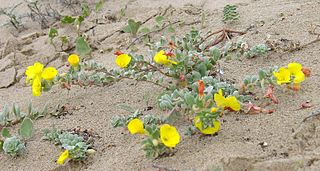
Camissoniopsis cheiranthifolia, the beach suncup or beach evening primrose, is a species of the evening primrose family and is native to open dunes and sandy soils of coastal California, Baja California and Oregon.

Erysimum menziesii is a species of Erysimum known by the common name Menzies' wallflower.

Oenothera deltoides is a species of evening primrose known by several common names, including birdcage evening primrose, basket evening primrose, lion in a cage, and devil's lantern. It is native to the Southwestern United States and northern Mexico, where it grows in sandy habitats from desert to beach.

Camissoniopsis micrantha is a species of flowering plant in the evening primrose family known by the common names miniature suncup or small evening primrose. This is a small, hairy annual herb producing a basal rosette of leaves. It is characterized by small yellow flowers with petals less than 5 millimeters long. The flowers dry to a reddish color as they close. This species is found in Arizona and California in the United States, along with Baja California in Mexico. It grows in sandy areas in a number of habitats, from beaches to inland slopes. It is the smallest member of the genus Camissoniopsis.

Selenicereus grandiflorus is a cactus species originating from the Antilles, Mexico and Central America. The species is commonly referred to as queen of the night, night-blooming cereus, large-flowered cactus, sweet-scented cactus or vanilla cactus. The true species is extremely rare in cultivation. Most of the plants under this name belong to other species or hybrids. It is often confused with the genus Epiphyllum.
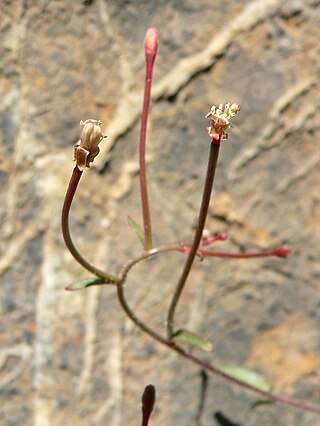
Eremothera chamaenerioides is a species of evening primrose known by the common name long-capsule suncup. It is native to the southwestern United States and northern Mexico, where it grows especially in desert regions. It is an annual herb producing an erect, hairy, glandular stem which is reddish in color and up to half a meter tall. The leaves are lance-shaped or oval and up to 7 or 8 centimeters long. The nodding inflorescence produces several flowers, each with white petals a few millimeters long and drying to dull red. The fruit is a capsule 3 to 5 centimeters long.
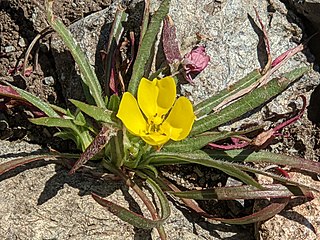
Tetrapteron graciliflorum is a species of evening primrose known by the common name hill suncup. It is native to Oregon and California, where it grows in several habitat types, often on clay soils. It is an annual herb generally with no stem but producing an upright, nodding inflorescence. There is a cluster of narrow leaves each one to ten centimeters long. The flowers have bright yellow petals one half to two centimeters long. The fruit is a leathery capsule less than a centimeter in length with four chambers containing bumpy brown seeds.
Camissonia lacustris is a flowering plant species commonly called grassland suncup. It is an evening primrose endemic to California, where it grows on the grasslands of the Sierra Nevada foothills. It is also known from an area in the Northern Coast Ranges in Lake County.

Camissonia parvula is a species of evening primrose known by the common name Lewis River suncup. It is native to the Great Basin of the United States. It grows in sagebrush, woodland, and other Great Basin habitat. It is a slender annual herb producing a wiry erect stem 15 to 30 centimeters in maximum height. The leaves are linear in shape and 1 to 3 centimeters long. They are located along the stem as there is no basal rosette. The nodding inflorescence produces flowers with yellow petals only 2 or 3 millimeters long. The fruit is a capsule 2 to 3 centimeters long, swollen with seeds, and sometimes coiling.
Chylismiella pterosperma is a species of evening primrose known by the common name wingfruit suncup and is the only species in the monotypic genus Chylismiella. It is native to the western United States, where it grows in several habitat types, including sagebrush. It is a slender annual herb producing an erect stem up to about 14 centimeters in height. The leaves are up to 3 centimeters long and densely coated in bristly hairs. The nodding inflorescence produces flowers with white petals each less than 3 millimeters long. They are sometimes yellow near the bases and fade to a purple color as they wither. The fruit is a straight capsule about 1 to 3 centimeters long with a thick wing down the middle.

Eremothera refracta is a species of evening primrose known by the common name narrowleaf suncup. It is native to the southwestern United States, especially desert areas. It is an annual herb producing a hairy red or reddish green leafy stem up to about 45 centimeters in maximum height. The nodding inflorescence produces flowers with white petals a few millimeters long which turn reddish as they wither. The fruit is a straight or coiling capsule up to 5 centimeters long.
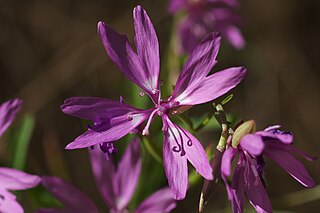
Clarkia biloba is a species of flowering plant in the evening primrose family known by the common name twolobe clarkia and two lobed clarkia.
Clarkia borealis is a rare species of flowering plant in the evening primrose family known by the common name northern clarkia. It is endemic to California, where it is known from the forests of the southern Klamath Range and the southernmost Cascade Range foothills. It is an annual herb growing an erect, slender stem. The leaves are oval in shape and borne on short petioles. The top of the stem is occupied by the inflorescence, in which the lowest flowers open first and hanging, pointed flower buds occur at nodes at the top. The sepals separate as the flower blooms, revealing purplish pink petals. Each petal is between 1 and two centimeters long, elongated triangular to semicircular in shape, and sometimes flecked with dark purple. There are 8 stamens with anthers bearing blue-gray pollen, and a protruding stigma.
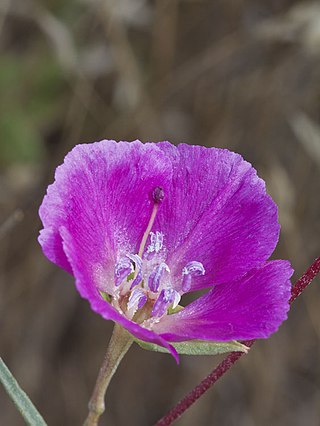
Clarkia speciosa is a species of flowering plant in the evening primrose family known by the common name redspot clarkia. It is endemic to California, where it is known from the Central Coast and mountains and from the Sierra Nevada foothills. The plant is variable across its intergrading subspecies, taking a decumbent to erect form with a stem up to about half a meter long. The open or dense inflorescence has opening flowers and several closed buds. As the bud opens the sepals all separate from each other. The fan-shaped petals are up to 2.5 centimeters long and may be lavender to pink to deep red, sometimes fading to white or yellowish at the base. There is sometimes, but not always, a large bright red spot near the middle of the petal.
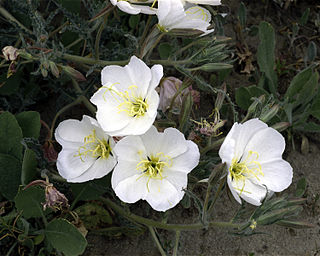
Oenothera deltoides subsp. howellii, the Antioch Dunes evening primrose, is an endangered subspecies of plant in the family Onagraceae, genus Oenothera, and species Oenothera deltoides.

Oenothera californica, known by the common name California evening primrose, is a species of flowering plant in the evening primrose family.

Oenothera primiveris is a species of flowering plant in the evening primrose family known by the common names yellow desert evening primrose, bottle evening-primrose, and desert evening-primrose.
Streptanthus insignis is an uncommon species of flowering plant in the mustard family known by the common names plumed jewelflower and San Benito jewelflower. It is endemic to California, where it is known only from the Inner Central Coast Ranges. It grows in grassland and chaparral habitat, usually on serpentine soils. It is an annual herb producing a hairy, bristly, branching stem up to about 60 centimeters long. The lance-shaped basal leaves are borne on short petioles. Leaves midway up the stem are longer, and those near the top are shorter. They sometimes clasp the stem at their bases. Flowers occur at intervals along the upper stem. The uppermost flowers are often sterile and different in form. Each fertile flower has a bell-shaped calyx of sepals which is purple or greenish-yellow depending on subspecies. The petals at the tip are purplish or yellowish, also depending on subspecies. The fruit is a flat, straight silique which may be over 11 centimeters long.
















